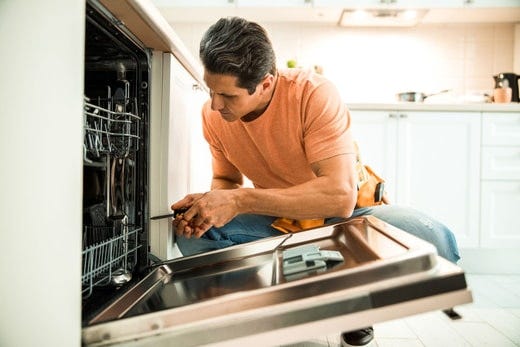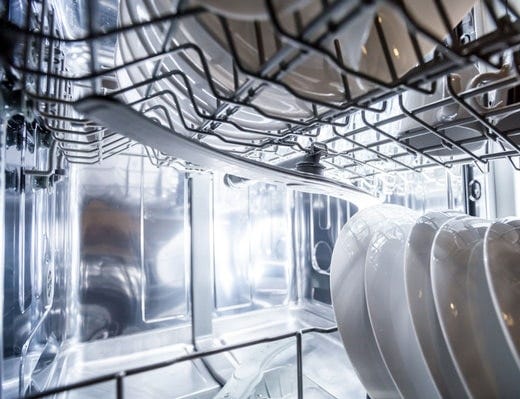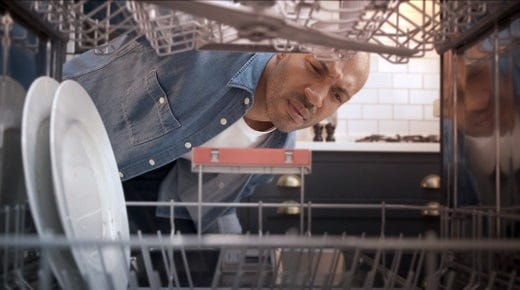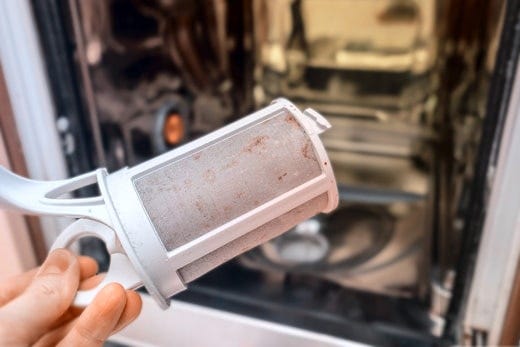
Dishwasher Not Cleaning? Troubleshooting Common Dishwasher Problems

Imagine this - you’ve finally gotten around to cleaning your kitchen after a long day of working, only to unload the dishwasher and realise that your plates and cutlery are still covered in last night’s dinner. It’s a frustrating situation, but unfortunately it’s all too common.
There are quite a few reasons why your dishwasher might not be cleaning your dishwasher safe cookware properly, or not draining correctly. Rather than instantly calling a professional to charge you hundreds of dollars to fix the problem, there are a few key parts of your dishwasher to check to see if they aren’t functioning correctly and troubleshoot the problem yourself. You may be able to solve some issues by yourself, saving time and money on repairs.
Your dishwasher not cleaning dishes can happen for a few reasons. Some problems are caused by food blockages, or issues with water temperature and volume, or a broken inlet valve. If this all sounds a bit confusing, Finish has your back - read on to learn more about some of the most common dishwasher problems, and the steps you can take to fix them. You’ll also learn how to avoid these problems in the future, to help keep your machine running and efficient for years to come.
Possible Reasons Your Dishwasher Isn't Working
There are a few key signs to look out for when you’re troubleshooting your dishwasher. If your dishes are still covered in food after washing, or if your dishwasher is not draining properly, it could be down to a clog in your dishwasher’s drain, filter, or spray arms. Clogs can also cause your dishwasher’s draining cycle to fail, leaving you with a dishwasher filled with water. Dirty dishes after washing can also be caused by a broken water heating element, soap dispenser, or inlet valve.
Thankfully, many of these issues are easy to fix- however, you need to know what is causing the problem in order to use the right repair method.
Dirty Filter
If your dishwasher is leaving food on your cleaned dishes, or you notice standing water in your dishwasher after a cycle, you may simply have a dirty or clogged dishwasher filter that needs clearing.
If you have a manual dishwasher (one that is not self-cleaning), you can easily remove the filter to clean it. First, check your dishwasher manual before attempting to remove and clean your filter. The filter will usually be located under the bottom dish rack in a back corner or near the spray arm.
Remove the filter by turning it counterclockwise and lifting it up, then remove and clean the mesh with warm water and soap.
Clean your dishwasher filter monthly to avoid future clogs.
Clogged Spray Arm
Another common site for clogs is your dishwasher’s spray arms. These arms have holes located along one side where water shoots out and cleans your dishes. Before cleaning the spray arms, check your dishwasher manual for more information.
You can remove these arms using the locking knob located on the underside of the arm. Once removed, simply dislodge any blockages with a piece of wire or even your fingers. You can also soak the arms in warm water or vinegar to dissolve any stubborn grime, grease, or mineral buildup.
When you replace the arms, make sure they can spin freely and don’t lock in place. Check your spray arms for clogs every month or so.
Clogged Drain
Once you rule out an arm or filter blockage, or if water is not draining from your dishwasher, check if the drain is clogged.
If you can’t identify any problem, or the hose is too damaged or blocked to fix, call a professional.
Broken Soap Dispenser
If you’re wondering why your dishwasher tablet doesn’t dissolve, your soap dispenser might be fused or melted shut, or the latch might be broken off.
If the dispenser latch is stuck, use a flathead screwdriver or a similar tool to pry the dispenser open.
If the dispenser is stuck due to mineral or detergent buildup around the latch, use a tool or some vinegar to gently break down the buildup, until the latch opens.
If the latch is completely broken off, you can usually install a replacement dispenser yourself - however, if your dishwasher’s control system is not opening the latch correctly during the wash cycle, you’ll need to call in a professional.
Water Temperature
If your dishes are still dirty, or not fully dried after a cycle, your dishwasher’s water may not be getting hot enough. After unplugging your dishwasher and checking for any clogs, check if the heating element (located under the bottom dish rack) is noticeably burnt. If it is, it is possible to replace it yourself, but it can also be done by a professional. If the element is fine, the problem may be due to a faulty thermostat, located near the heating element.
You can check for an electrical fault using a multimeter- any reading other than zero ohms means you need to call in a professional.
Water Pressure/Volume
If your dishes still aren’t cleaning properly, you may have an issue with water pressure and volume. Check if your dishwasher is getting enough water pressure by pouring around 1L of water into the bottom of your dishwasher and running a cycle- if there is an improvement, then your dishwasher may not be getting enough water from your home’s water supply.
Check your dishwasher’s manual for instructions on adjusting the water pressure. After increasing the pressure, run the dishwasher again to check if the problem is fixed- if you are still having water volume issues, contact a professional.
Failing Inlet Valve
If your dishwasher is not filling completely, makes strange noises as it fills, or still isn’t cleaning your dishes properly, then you may have a problem with the inlet valve. This is the valve that controls the amount of hot water entering your dishwasher, and it can become faulty if it becomes clogged.
To check the inlet valve, turn off the power and water to your machine and locate the valve, usually near the access panel. Unscrew the valve with pliers, being mindful of water spills, and remove the hose. If the valve is damaged you can try to replace it yourself, or contact a professional.
How Finish Can Help
Help avoid future problems by taking good care of your dishwasher.
Always make sure you dispose of big pieces of food in the rubbish before putting your dishes in the dishwasher. Stacking your dishwasher correctly can also make a big difference when it comes to dishwasher efficiency. Try high quality detergents, like Finish Ultimate Plus Dishwashing Tablets, and clean your dishwasher’s filter at least once a month to make sure your machine stays free from clogs or detergent buildup.
You can also use a deep cleaner like Finish Dishwasher Deep Cleaner periodically, to help remove grease and limescale that may be hidden in your dishwasher.



